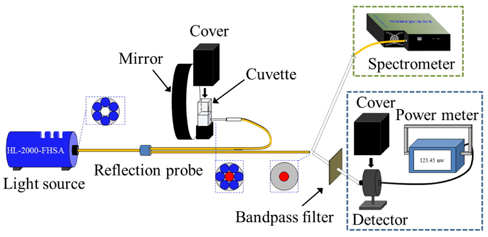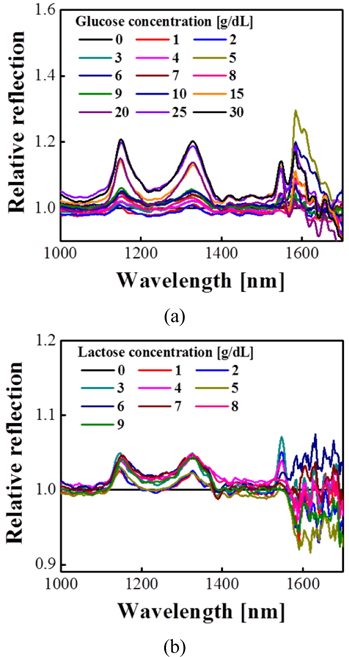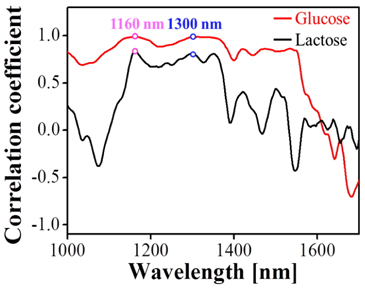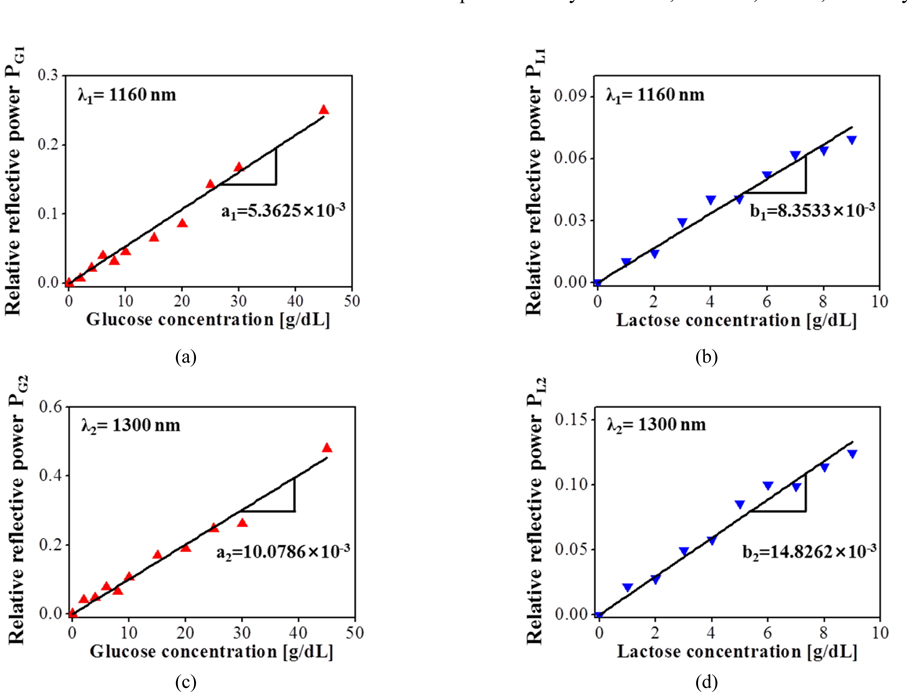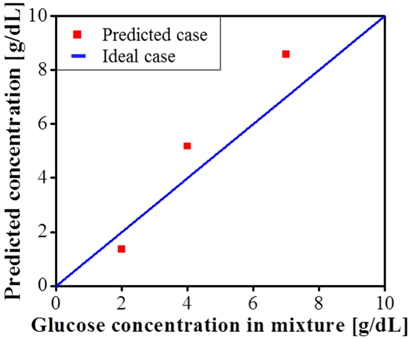



The detection of high concentrations of glucose in complicated mixtures has attracted an abundance of attention in the food, beverage, and fermentation industries, as well as in the treatment of disease in domestic animals, where glucose mostly acts as a vital substance and is present in high concentrations, from 1 to 10 g/dL [1-8]. Schemes employing highly efficient liquid chromatography and glucose oxidase have been used to predict high glucose concentrations in a complex situation [2-8]. However, most previous approaches were susceptible to several critical disadvantages, including sample destruction, short enzyme lifetime, long measurement time caused by either the catalytic reaction or substance separation process, and high cost resulting from immobilization of the enzyme. To mitigate these issues, optical detection schemes have been adopted for their salient features, including an enzyme-free process, fast response, and the potential for noninvasive detection. Absorption spectroscopy based on Beer’s Law assumes a linear relationship between glucose concentration and absorbance [9-14], which is only good for concentrations below hundreds of mg/dL [15]. It has been noted that a bulky, expensive spectrometer is required to continuously monitor the absorption spectrum [10, 12].
In this paper, an enzyme-free optical method is proposed and demonstrated to predict high concentrations of glucose in a glucose-lactose mixture, by drawing upon the reflective optical power observed at two probe wavelengths. It is noted that lactose in particular is selected as the interfering material to better mimic practical situations, considering that it is one of the most common components of food and beverages [16]. By investigating the wavelength-dependent correlation coefficient (
II. PROPOSED GLUCOSE DETECTION USING REFLECTIVE OPTICAL POWER FROM A GLUCOSE-LACTOSE MIXTURE
Rather than using absorption spectroscopy based on Beer’s Law, we aim to predict glucose concentrations as high as several g/dL in a glucose-lactose mixture by exploiting the reflective optical power available from the mixture. This power is observed by employing a mirror, without resorting to a spectrometer, which is potentially desirable for noninvasive glucose detection. Actually, the prediction relies on the relative optical power, which is tantamount to the observed optical power normalized with respect to the signal available from pure water. The proposed detection scheme involves the following two equations, implying a linear relationship between the concentration of pure glucose/lactose solution and the corresponding reflective power [13, 17]:
For
We have chosen probe wavelengths
For a total of
For a total of
III. VALIDATION OF THE PROPOSED GLUCOSE DETECTION SCHEME
To assess our approach for predicting high glucose concentrations in a glucose-lactose mixture, we selected two prominent probe wavelengths that led to high correlations between concentration and reflective optical power. A set of pure glucose and lactose standard solutions of various concentrations was prepared in a volumetric flask by dissolving D-(+)-glucose and α-lactose powder (Sigma-Aldrich) in deionized (DI) water at room temperature. The standard solution was then poured in a quartz cuvette of path length 10 mm. The glucose concentration was varied from 1 to 45 g/dL, while the lactose concentration was limited to a range of 1 to 9 g/dL, due to its lower solubility. To investigate the reflection spectra for the reference glucose and lactose solutions, we built a test setup as shown in Fig. 1, incorporating a spectrometer (NIRQuest512-2.5, Ocean Optics) and a halogen lamp (HL-2000-FHSA, Ocean Optics), with no bandpass filter inserted. Light from the lamp, which is delivered via the six surrounding fibers belonging to its reflection probe, was shone onto the prepared solution. Light transmitted through the solution was reflected back from a mirror to the central fiber of the reflection probe, for analysis by the spectrometer. During measurement the solutions and detector were entirely isolated from ambient light. The calculated reflection spectra for the two types of solutions are presented in Fig. 2, in the near-infrared regime from
The linear coefficients
An enzyme-free optical scheme for detecting high concentrations of glucose in glucose-lactose mixtures was realized by utilizing the reflective optical power available from the mixture, observed at dual probe wavelengths of 1160 and 1300 nm. The predictive equation was established based on the linear relationship between reflective optical power and glucose/lactose concentration at the specified wavelengths. For a glucose-lactose mixture, glucose concentrations from 2 to 7 g/dL were successfully estimated, achieving a standard error of prediction of 1.17 g/dL. It is noted that to practically apply the proposed method, for initial calibration a reference solution of pure DI water should be measured.



